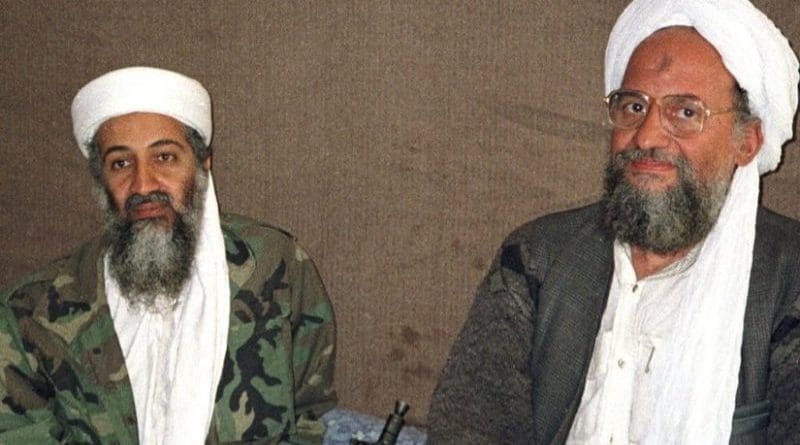Osama’s Demise And Zawahiri’s Rise: Weakening Of Al Qaeda – Analysis
Ayman Al Zawahiri’s rise as leader of Al Qaeda could increase internal disunity and weaken the terrorist organisation. Outside the Afghan-Pakistan theatre its threat will be limited to instigating associates in the Arabian peninsula and self-radicalised individuals elsewhere.
By Muhammad Saiful Adli Ayob and Muhammad Haniff Hassan
FOLLOWING THE death of Osama bin Laden, the rise of Ayman Al Zawahiri as the new leader of Al Qaeda is likely to reopen old divisions within the organisation. There were two major factions in Al Qaeda when it was formed. One comprised Osama bin Laden’s followers from the Arabian peninsula and other countries, as well as volunteers with no previous affiliation to militant organisations, fighting the Soviet army in Afghanistan. The other was the Egyptian Islamic Jihad (EIJ) faction led by Ayman Al Zawahiri. The faction of Osama and others were discontented with the over-representation of EIJ members at the leadership and operational levels.
The Egyptians numbered more than half the group that formed the initial Qaeda al-Jihad and held most of the major appointments. Thus Zawahiri was the second-in-command to Osama while Abu Ubaidah al Banshiri was Qaeda’s military chief, later replaced by Mohamed Atef a.k.a abu Hafs Al Misri. He in turn was replaced after his death in the September 11 attacks by Saif al Adel, a former Egyptian army colonel, and Mustafa Abu Yazid, who oversees Al Qaeda in Afghanistan.
Saudi-Egyptian rift
The Saudis and Yemenis felt they should have a fair share of key positions because they formed a major contingent of foreign volunteers in Afghanistan, gave more financial support and came from the land of Prophet Muhammad and the two holiest cities in Islam.
Osama was able to keep the divisions in check by his willingness to accept the Egyptians’ over-representation in key positions so as to tap their jihadi experience and military expertise which the Saudis were lacking. The EIJ has more than a decade of experience in militant jihad, with ideological depth and organisational ability as their members included former Egyptian military and police officers. Osama was able to pacify them by virtue of his charisma, financial backing and his authority as emir whom the members were required to obey without question. The Saudis were appeased by the fact that their leader, Osama, was the emir of Al Qaeda.
EIJ monopoly
After Osama’s death Zawahiri’s appointment as the new emir completes the EIJ’s monopoly of Al Qaeda. Without the rallying factor of Osama, Al Qaeda Central faces the real risk of a mass exodus of the Osama faction members who have long been discontented. It is doubtful that Zawahiri will be able to strategically address and heal this rupture. Osama’s faction would either leave for other groups or become inactive.
Indeed, there is every likelihood that Al Qaeda Central will revert to being the old EIJ with a new name — a failed organisation before its merger with Al Qaeda. In fact, the current EIJ is weaker than before the merger because of the revisionist view of the group’s former ideological leader, Dr Fadl. Currently imprisoned in Egypt, Dr Fadl now regards as illegitimate armed jihad for regime change in Muslim countries and against Western states as currently practised by al-Qaeda. Fearing it is causing greater harm than good, he has also denounced al-Qaeda’s tactic of indiscriminate attacks.
Limited threat
Al Qaeda Central will have little operational impact outside the Afghan-Pakistan theatre. Its activities outside the theatre will be limited to propaganda work to instigate self-radicalised individuals and members of Al Qaeda franchises in the Arabian Peninsula, Iraq, North Africa and its associates elsewhere such as Jemaah Islamiyah in Indonesia.
The possible fragmentation of Al Qaeda Central following the anointing of Zawahiri as the new emir will, however, not mean the demise of the organisation. However, it will strengthen counter-terrrorism initiatives the world over, besides inviting an intensified US harassment on Qaeda elements in the Afghan-Pakistan border region. Coupled with the internal problems of Al Qaeda Central, the counter-terrorism offensive will significantly weaken and limit its effectiveness.
The threat of terrorism will then come primarily from self-radicalised individuals out to attack US targets such as the Times Square bombing attempt (May 2010); and attempts by Al Qaeda in the Arabian Peninsula (AQAP) to blow up US airliners by means of an underwear bomb device in 2009 and a loaded printer cartridge that was couriered in 2010.
More effort and resources will have to be deployed to address these two sources of threat – self-radicalised individuals and AQAP. A speedy resolution of the insurgency problem in Afghanistan, which will allow the withdrawal of US and NATO military forces, will contribute directly to this effort; more resources and focus can then be directed to these threats. More importantly, it will deny Al Qaeda Central the potent source of propaganda that has been radicalising many individuals — its last source of strength.
Muhammad Saiful Adli Ayob is a Senior Analyst and Muhammad Haniff Hassan is an Associate Research Fellow at the S. Rajaratnam School of International Studies (RSIS), Nanyang Technological University.

